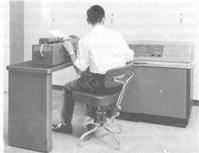


Chapter 8
I Part 1: Communications
II Epilogue
III Part 2: Early Australian Computers And Computing
i Instruments and calculators
ii The transition to the computer, 1945 to 1951
iii The first computers, 1951 to 1956
iv Concentration on large-scale systems, 1958 to 1963
v Software and microelectronics, after 1965
vi Industry, education and the computing fraternity
IV Acknowledgements
References
Index
Search
Help
Contact us

Concentration on large-scale systems, 1958 to 1963
In this period, all chance of Australia building up a significant computer industry was lost; but technically important design work was carried out which had considerable effect upon computer designs in the UK, although with little or no profit locally. Overseas manufacturers concentrated upon the design and production of large general purpose systems, more or less ignoring special purpose designs. Local attention tended to concentrate upon the application of these large systems and thus become software oriented.The SMI ceased to exist in 1959, when Myers moved to the University of British Columbia. It was effectively incorporated into the Department of Electrical Engineering of the University of Sydney. Computer design there was thereafter directed to some small scale systems for educational purposes except for the SNOCOM (Wong, D. G., 1962). Its design (by M. W. Allen) was based upon the elegantly simple vacuum tube LGP-30 and was built for the SMHA, when it was found that such a computer would be more suitable for its design work than the ADA. Its program library had been developed by J. C. Butcher while it was being built, using an interpreting programme on the SILLIAC which was designed and constructed by J. M. Bennett and M. A. Chapple. It was installed at the SMHA headquarters at Cooma, NSW, in 1960, where it continued in service until 1967. It is now part of the National Historical Collection of the National Museum of Australia, Canberra. Its speed was about half that of the CSIRAC. The development of small machines was continued by D. G. Wong and K. R. Rosolen at the Department of Electrical Engineering for educational purposes and on-line process control by the design and building of the ARCTURUS and others between 1960 and 1966 (Wong, D. G., 1966). The ARCTURUS was eventually coupled to an IBM RAMAC (Rosolen, K. R., 1968).

In 1958 M. W. Allen moved to the Department of Electrical Engineering of the University of Adelaide. Early in 1959 Pearcey returned to join the CSIRAC Laboratory with the task of developing computing within CSIRO. Conversations led to a plan for the design and building of the Cirrus which was to use the then relatively new ferrite core store, required by Myers, and to exploit the use of magnetic read-only storage, of the possibilities of which Pearcey was now convinced after his contact in the UK with the microcode of the EDSAC II and the subroutine library store of both the EDSAC II and the TREAC. The Cirrus was designed to minimise equipment by keeping its components in constant use cycling data to and from store within each duty cycle. Equipment cost of about £20,000 was supported by WRE and PMG's Department. It was one of the earliest machines to be able to handle concurrently more than one user, each provided with paper tape, keyboard and printer and used read-only store at four software levels, as microprogram, sub-routine library, operating system and compiler. Execution rates were more than double those of the SILLIAC. All microcode routines were checked out on the CSIRAC by interpretation.
It was a design which lent itself readily to accommodate a number of microcoded operation sets at low cost of hardware, thereby allowing it to be tailored to particular types of application. As such, its design offered an opportunity for economic development. This opportunity was not followed up by the University or by the design team, which moved on to other interests and institutions (Allen, M. W., Pearcey, T., Penny, J. P., Rose, G. A. and Sanderson, J. G., 1963; Pearcey, T. and Penny, J. P., 1962). Allen was to accept the Chair of Electrical Engineering in Computing at UNSW after a year with Control Data developing microcoded extensions of its 3000 series. Rose was also to go to UNSW and Penny was to join the CSIRO Section of Computing Research. The Cirrus began service in Adelaide in 1962.
Organisations in Australian Science at Work - CSIRO; CSIRO Division of Electrotechnology. Section of Mathematical Instruments; CSIRO Section of Computing Research; National Museum of Australia; Snowy Mountains Hydroelectric Authority (S.M.H.A.); University of Adelaide. Department of Electrical Engineering; University of Sydney; Weapons Research Establishment (W.R.E.)
People in Bright Sparcs - Allen, M. W.; Bennett, J. M; Butcher, J. C.; Chapple, M. E.; Myers, D. M.; Pearcey, T; Penny, J. P.; Rose, G. A.; Rosolen, K. R.; Sanderson, J. G.; Wong, D. G.
 |
Australian Academy of Technological Sciences and Engineering |  |
© 1988 Print Edition pages 621 - 622, Online Edition 2000
Published by Australian Science and Technology Heritage Centre, using the Web Academic Resource Publisher
http://www.austehc.unimelb.edu.au/tia/592.html